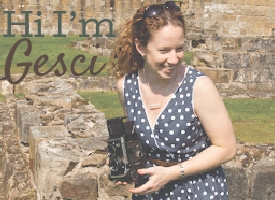I've walked around the Minster several times, and into the vestibule twice, but this was the first time I've gone in the Minster. Before we get there in our pictorial you'll have to scroll through some outside shots.
What we see as the Minster was built between the 13th and 15th centuries, although it has been restored from two major fires in the 1800s and it's own settling weight in more recent times.
The Minster is constantly under close scrutiny to maintain it's structure and beauty. There is a display inside showing how the building's stones are carefully and delicately recreated in order to seamlessly replace crumbling pieces, but the York Minster Revealed project describes this as well. The stained glass windows are also being cared for in the same fashion, along with being restored to their original designs by removing lead repairs from previous centuries.
Constantine sits at the entrance as the bringer of Christianity to the West.
Moving inside, this is the quire screen. Built to separate the shriven from the lay people, the original screen was destroyed in the fire of 1829, but was recreated from drawings during the next decade.
I'll apologize for the poor lighting and sometimes camera shake, I don't use my flash inside because of the risk of damage to non-stone relics. If you look closely you can see the individual seats for the canons, each of which has a badge showing the canon's prebend.
The most (arguably, of course!) famous part of the quire screen is the King's Screen, surrounding the western entrance to the quire. Flanking the entry are fifteen carved kings, William the Conqueror to Henry VI. These were carved in the early 1400s as part of what is believed to be a support wall between the two eastern arches of the tower (the tower collapsed in 1407).
You'll notice (maybe, if you look closely) that Henry VI (the guy on the farthest right) doesn't have the same gape-mouthed, mad-scientist hair look as the other kings. This is due to this particular Henry's being carved in 1810. Why so much later than the others? According to the story, the previous Henry VI statues were all destroyed or removed by local Yorkshire folk, since Henry's disastrous reign led to the War of the Roses between the Lancastrians (Henry VI's side) and the House of York.
I'm honestly not sure who's effigy this is, but I thought it both presumptuous and entertaining that he's got his feet resting on the lion. Plus this lion looks a lot like the talking lion from a show I like, Wonderfalls.
Back to the Minster... this is a view down the Nave, from the tower area.
I'm quite infatuated with stained glass, so of course I paid extra attention to the windows. I'm curious to the faint drawings in the "clear" areas of some of the windows. This image shows them best, if you care to click it larger.
I'll take more pictures the next time we go, but if you're interested in the religious houses this is definitely one to see. I will suggest, though, that before you come visit you read Pillars of the Earth, by Ken Follett. A historical fiction book (and a doozy of a volume it is), it provides immense background information on the actual architecture and construction of a cathedral. It's a great read, too. I was fortunate to discover it before we started seeing the religious ruins and cathedrals, and I feel it gave me some insight to what I'm viewing. "But you don't have to take MY word for it!" (gold star if you get that reference!!)


























No comments:
Post a Comment
Thanks so much for stopping by! I can't wait to read your comment!